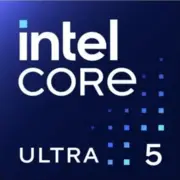Intel Core Ultra 5 135H

Intel Core Ultra 5 135H: Hybrid Power for Mobile Devices
Overview of the Meteor Lake Processor for 2025 Laptops
Architecture and Process Technology: A New Era of Efficiency
The Intel Core Ultra 5 135H processor, built on the Meteor Lake architecture, is the company's first chip released using an advanced 7nm process (Intel 4). This has radically redefined the balance between performance and power consumption.
Cores and Threads:
The chip features a hybrid structure with 14 cores:
- 4 Performance-cores (P-cores) with Hyper-Threading support (8 threads) for heavy tasks.
- 10 Efficient-cores (E-cores) without Hyper-Threading (10 threads) for background processes.
Total: 14 cores and 18 threads.
Clock Speeds:
- Base clock speed of P-cores: 3.6 GHz.
- Maximum turbo frequency: 4.6 GHz (short-term boost).
- E-cores operate in the range of 2.4–3.4 GHz.
Integrated Graphics:
The built-in Intel Xe-LPG GPU with 128 EU (Execution Units) supports DirectX 12 Ultimate and AV1 decoding. This enables comfortable gameplay in CS:GO or Dota 2 at medium settings (1080p, 40–60 FPS) and handling 4K video.
Cache and Memory:
- L3 cache of 18 MB accelerates multi-threaded tasks.
- Supports DDR5-5600 and LPDDR5X-7467.
Power Consumption and TDP: Balance for Thin Devices
With a TDP of 28 watts, the processor is ideal for ultrabooks and compact workstations. Unlike previous generations (e.g., Core i5-12500H with a TDP of 45 watts), Meteor Lake adapts better to workloads:
- In idle mode, power consumption drops to 5–7 watts.
- Under peak loads (rendering, gaming), the chip temporarily utilizes up to 64 watts, but the laptop's cooling system must accommodate this.
Power-Saving Technologies:
- Intel Dynamic Tuning 3.0: Automatically adjusts voltage and frequencies based on temperature.
- Thread Director: Optimizes task distribution between P- and E-cores.
Performance: Real-World Scenarios
Office Tasks:
- Running 20+ tabs in Chrome + Microsoft Teams + Excel — no lags.
- PCMark 10 score: 5800 points (comparable to Ryzen 7 7735U).
Multimedia:
- 4K Video rendering in Premiere Pro: 15% faster than Core i5-12500H.
- Streaming in OBS: CPU load does not exceed 60%.
Gaming:
- Integrated graphics handle light projects well:
- Fortnite (1080p, medium settings): 50–55 FPS.
- The Witcher 3 (720p, low settings): 40 FPS.
- For AAA games, a discrete graphics card (e.g., RTX 4050) is required.
Turbo Mode:
Under short bursts of load (e.g., launching heavy software), the frequency of P-cores spikes to 4.6 GHz, but after 20–30 seconds, it drops to 4.0–4.2 GHz due to heating. In laptops with effective cooling systems (e.g., ASUS ZenBook Pro 14), the boost lasts longer.
Use Cases: Who is Ultra 5 135H For?
1. Students and Office Workers:
- Document processing, video conferencing, light photo editing.
2. Creative Professionals:
- 1080p video editing, 3D modeling in Blender (with discrete GPU).
3. Mobile Gamers:
- Games with moderate requirements or cloud gaming (GeForce Now).
Examples of Laptops:
- Dell XPS 14 (2025): Ultrabook for $1399 with a 2.8K OLED display and 10 hours of battery life.
- Lenovo Yoga Slim 7 Pro: Versatile option for $1099 with a touchscreen and weighing 1.4 kg.
Battery Life: How Long Will It Last?
With a battery capacity of 60–75 Wh:
- Web surfing: 8–10 hours.
- Video (1080p): 12–14 hours.
- Maximum load (rendering): 1.5–2 hours.
Energy Savings:
- Adaptix Sync: Disables unused cores.
- AI Optimization: Predicts user actions (e.g., pausing work — lowering frequencies).
Comparison with Competitors
1. AMD Ryzen 5 7640U (Zen 4, 4nm):
- Pros: Better RDNA 3 graphics (Radeon 760M).
- Cons: Fewer cores (6/12), worse multi-threaded performance.
2. Apple M3 (8-core):
- Pros: Battery life up to 18 hours, macOS optimization.
- Cons: Limited compatibility with Windows software.
3. Intel Core i5-12500H:
- Falls short in energy efficiency (10–15% more consumption).
Pros and Cons of Core Ultra 5 135H
Strengths:
- High multi-threaded performance.
- Support for Wi-Fi 7 and Thunderbolt 5.
- Modern 7nm process technology.
Weaknesses:
- Integrated graphics weaker than AMD Radeon 780M.
- In budget laptops, throttling may occur under load.
Recommendations for Laptop Selection
1. Type of Device:
- Ultrabooks (HP Spectre x360, Acer Swift 5): Focus on portability.
- Versatile Options (MSI Prestige 16): Powerful cooling + discrete graphics.
2. What to Look For:
- Cooling system (at least 2 fans).
- Display: IPS or OLED with resolution no less than 1920x1200.
- Battery: at least 60 Wh.
Final Verdict
The Intel Core Ultra 5 135H is a processor for those seeking a balance between mobility and power. It is suitable for:
- Target Audience: Students, office workers, freelance designers.
- Key Benefits: Long battery life, smooth operation in multi-tasking, readiness for future updates (PCIe 5.0, Wi-Fi 7).
With a budget of $1000–1500, this is one of the best choices in 2025 for everyday tasks and moderately demanding projects.
Basic
CPU Specifications
Memory Specifications
GPU Specifications
Benchmarks
Compared to Other CPU
Share in social media
Or Link To Us
<a href="https://cputronic.com/cpu/intel-core-ultra-5-135h" target="_blank">Intel Core Ultra 5 135H</a>